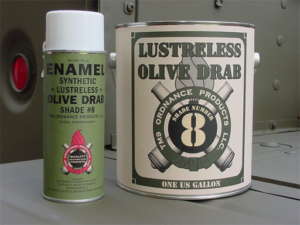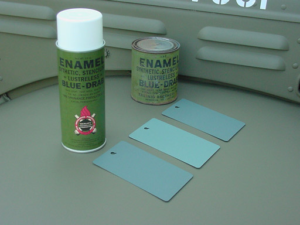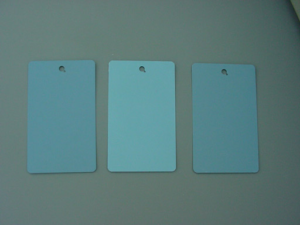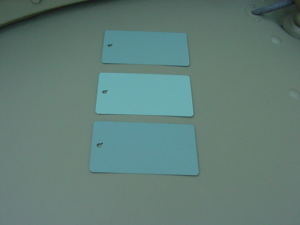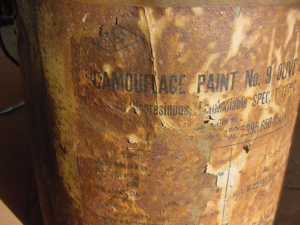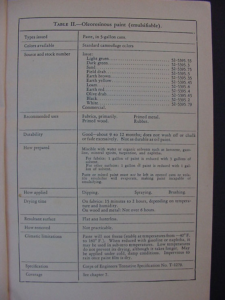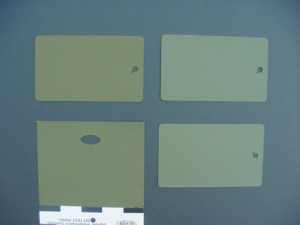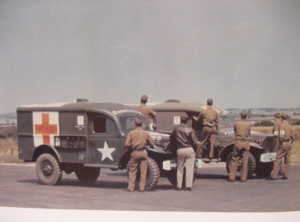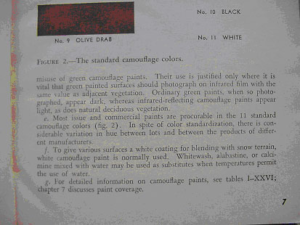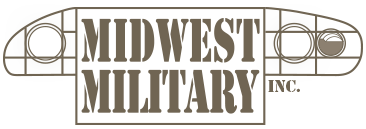U.S. Army 1950-1956 vehicle Olive Drab is finally uncovered.
After years of searching an original paint chip for OD2430 has surfaced. Amongst the vast collection of a well known vehicle and paint expert in Pennsylvania, the original 1950 paint chip has finally seen the light of day. It is a very brown shade of OD that was replaced with the greener shade of OD in 1956 by 24087. This is the standard color all vehicles left the factory with from late 1950 through 1956. This color is available in enamel, both gallons and spray paint. So if you want your Korean War Dodge M37 or M38A1 painted with an accurate color, you finally have a source that can meet your needs.
WWII USMC Forest Green
After a few years of research I was able to obtain original paint chips of Forest Green from 1943, 1949 and 1953. Original WWII USMC paint has been impossible to find since most of it was sold to the US Postal Service in the late 1940’s. Using these paint chips as well as referencing NOS International Harvester parts, it was clear as to what the shade of Forest Green was during the WWII and immediate post war era. This paint shade is a strikingly different green. At first it is hard to reconcile that this is the shade used, but then again the Marines were fighting a jungle war for the most part and their vehicles needed to blend in with tropical foliage. I thought the best way to highlight this was to paint a .50 BMG ammo box and place it on my M-20 and almost completed Ben Hur. Both of these are painted in TM9 OD Shade #8 (OD319). You can see the striking difference. I have also attached two pictures of an IH M5-6 being restored using the TM9 USMC urethane paint.
Yellow Drab #316
WWII Yellow Drab #316 is now available in spray cans. This shade of yellow was reengineered from an original can of paint from WWII and an original copy of the US Army Spec. 3-1 paint chip manual dated April 1943.
Replicating any shade of pre 1965 yellow is very difficult since yellow paint prior to then is basically pure lead, commonly known as chrome yellow. This shade is much different than the shades currently available from any source and will add the finishing touches to those Bridge Plates, crate stencils, 2nd Armor markings, Sicily Campaign markings and land mines such as the ones I am finishing for my M-20 armored car.
Synthetic Enamel Semi-gloss Olive Drab Spray Paint for metal WWII USGI Ammo Cans.
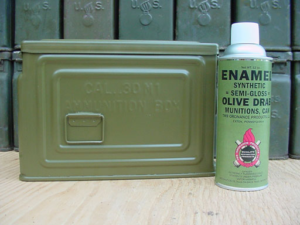
The image above shows a .30 ammo can that I stripped, did not prime, and then painted with this new paint.
I have almost 200 WWII metal ammo cans. The overwhelming majority of these cans have been repainted at least once during their service. This is evidenced by the contrast between the darker post war lustreless olive drab found on the outside, and the lighter semi-gloss olive drab shade found on the majority of the insides.
I opened about forty .30 and .50 ammo cans and spread them out. I then separated them by manufacturer. As a side note, most of the .50 ammo cans I used for this study were the side opening ones made between 1940 and about December of 1942. There are three different types of side opening .50 ammo cans used after the side opening M17 .50 ammo can was replaced.
The first step was to compare these cans to two original .30 ammo cans that my father brought back in 1945 (kept in a foot locker in my grandparent’s house until I retrieved them). On one of these cans I took the top handle off. The image below shows this handle on top of a can that I stripped and painted, the second image is a close up of the inside of a can lid that I did not paint, only cleaned with a damp rag.
The second step was to start pulling back the top carrying handles back on cans that have the lighter shade remaining inside the lids. Based on this I was able to conclude that there were two different shades of semi-gloss paint used to paint these cans during the War. About eighty-five (85%) percent of the .30 ammo cans are painted in a lighter shade, and about twenty-five (25%) of the .50 ammo cans are painted in this same shade. The third step was to compare these shades to original WWII color paint chips in day, iridescent, and florescent light. The following images show some good comparative olive drab shades. The first image shows one of the cans brought back by my father on top of the others. You can also see the difference between the lighter semi-glosses OD on the inside of cans versus the post war painted darker olive drab on the outside.
Obviously these few images above do not come close in recording the amount of effort that this project required over the last year.
It was fairly obvious that this lighter shade matched one of the paint chips. This good news connected some real dots regarding providence. I then sent the paint chip off to the factory to be replicated. (Editorially, I came upon this paint chip through the diligent work of a colleague in California.) After numerous attempts by the factory they finally made a shade that I was satisfied with and production was underway.
Finally, another WWII shade of OD has been faithfully replicated. Whether a vehicle restorer/owner, a weapons collector, a reenactor, or all three, in the end you now have an accurate solution.
TM9 Lustreless Olive Drab Shade #8
The images that follow show a freshly painted M18 Hellcat using TM9 Lustreless Olive Drab Shade #8 and a newly installed NOS taillight. Using the correct shade of Olive Drab can save you time and money when installing NOS parts.
Lustreless Olive Drab Shade Number 8 is also available in AIR DRY SYNTHETIC ENAMEL.
This particular paint is the highest quality the chemistry of synthetic enamel paint products allow. You will not be disappointed!
Since many of you have been using synthetic enamel paint on your vintage military vehicles for many years, there is virtually no learning curve as to its application. Just stir it up properly, reduce up to fifteen (15%) percent with Xylene, and spray. And since this Lustreless Olive Drab is a single stage paint, it is available in 12 oz. spray cans! Please check the Midwest Military store for pricing details.
You now have NO reason or excuse to continue painting your WWII era vehicles in shades of Olive Drab that “are close enough”.
Lustreless Blue Drab
During the WWII era, all U.S. Army military vehicles were assigned a registration number at the factory of origin. Once the vehicle was assembled and out the door, it was driven to a holding area, usually outside. Factory employees, with three part gum backed oil boards in hand, applied these registration numbers by stencil to the vehicles. Brass stencils were not really used at this point of the vehicles life. The registration number was stenciled onto the vehicle using paint out of a can and a stipple stenciling brush. No other markings, such as stars and unit markings were applied at this point either in blue or white. For the most part the style of numbers and fonts were not all the same, but the overwhelming majority were of the closed character type (See Manual AR850-5) without the traditional break marks usually associated with stenciled numbers and letters.
In November of 2006 we received an original can of 1944 Lustreless Blue Drab paint from Kevin Kronlund of Army Cars USA. This paint had never been opened.
Once opened this paint was reduced by about 15% with Naphtha, and sprayed on a number of Q panels. True to its original chemistry, it dried very slowly and produced a lustreless flat finish.
Compared to Q panels that were recently painted with a currently available Blue Drab paint it was obvious that there was some distance between colors, not just hues. Without any doubt, this shade was the hardest to replicate to date. We rejected six samples from the manufacturer. The finish was too glossy, too blue, too gray, etc. This shade is actually much greener and grayer than what is currently available.
For your reference, I have four different MG oil cans with blue lettering. The color of blue on these cans does not match the original WWII Lustreless Blue Drab paint.
The following images show the final product next to its container. Also shown is the other product that has been available for quite some time.
So if you are looking to replicate a factory vehicle, and want to use the same color as used during that time period, you can have the confidence that this is the correct shade. TM9 Ordnance Paint is on the left in the next image, the original paint sample is on the far right.
TM9 Ordnance Paint is on the bottom in the next image, the original paint sample is on the top.
This spray paint can be used on top of almost all types of paint. As with all paints you should test first.
Additional paint research
The first image is that of a portion of a label of an original 5 gallon bucket of paint from WWII.
The label on this original era paint reads:
Camouflage Paint No. 9 Olive Drab
Oleoresinous, Emulsifiable Spec. T-1279C
52-5395.650-050
Hilo Varnish Corporation in Brooklyn, NY.
This is not the paint used in the factories to paint vehicles as they came down the assembly line, but rather the paint (in paste form) issued to ordnance and motor pool units to be utilized for the repainting of vehicles in the field. The second image is from an original FM5 manual dated July of 1944.
This bucket of paint was completely covered in surface rust after sitting in a barn for many years. Well after about six hours with wire brushes, a pile of rags, and about half a gallon of phosphoric acid, I was able to clean the outside of the can to the point I felt comfortable trying to get it open. Like all paints of this era, I expected to find a rubber gasket between the lid and the can. Its presence would be the first clue as to whether the contents were original and would have had a chance to stand up to over 60 years of neglect.
The gasket was present and served its purpose way beyond the intended requirements of the 1940’s. You can see the remnants of the gasket as well as the pigment I pulled from the bottom of the can.
Using a half-inch drive drill, three different sized paint mixers and a pry bar, and eight hours in the drill press, the paint was completely mixed. As the manual states, it can be reduced at a 50:50 mixture with a number of solvents. I then transferred most of this paint into new one gallon and quart containers.
The next two images are of a painted Q panel of TM9 Lustreless Olive Drab #2 next to a Q panel I painted from this original 5 gallon can of paint reduced with mineral spirits. I call these images: “The Money Shot”.
The next image includes that of a Q panel painted with TM9 Lustreless Olive Drab Shade #8, next to a spray card that Jim Gilmore gave me. The spray card is painted with paint that was manufactured by the Hoboken White Lead and Paint Company, January 1944 Spec., also in Brooklyn NY.
This shade was also developed independent of having an original paint sample. However, once Jim Gilmore provided me with this sample I was able to make some slight adjustments to the production of Shade #8.
So if there is any doubt as to which shade you should use on your vehicle, it is solely based on your personal preference.
“Which shade is correct for my WWII _________?”
The number one question asked is, “Which shade is correct for my WWII _________?” The answer is all of them! Which one do you like?
The second most asked question is, “Which one is 319?” The answer is none of them!
Remember No. 319 is not a shade or color; it is a type of paint that deals with the reflective quality (natural light & infrared) of the actual components (e.g. chromium oxide) in the paint that directly affects reflective quality of the applied paint.Most Lustreless Olive Drab paint used during the war was of 319 specification, but not all. For example, 319 spec. Olive Drab paint would not be required on items that by nature have a short shelf life in the field. Bombs for example.
Look at the color photograph below. It was taken during the war. The actual shade of the Olive Drab used on the WC-54’s is not as important as the notable difference in the shade and hue of the paint. Could the difference also be from having a newer vehicle (or an older one recently painted) that was put into service next to an older vehicle? Perhaps, but again the difference is significant! Which one do you like?
“America at War in Color”, by Stewart Binns & Adrian Wood, published by Carlton Books Limited, 2001
For the most part there was one specification for Lustreless Olive Drab paint during the war. With so many manufacturers producing the product, measuring processes not as accurate as today, and the human factor related to the stress of a world war, it is not only reasonable to assume that different shades and hues were produced, accepted, and applied, it was acknowledged during the war.
Please read: the second sentence, paragraph e., page 7, FM5-20H, dated July 1944.
“In spite of color standardization, there is considerable variation in hue between lots and between the products of different manufacturers.”
So, which one do you like?































